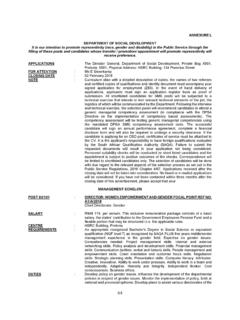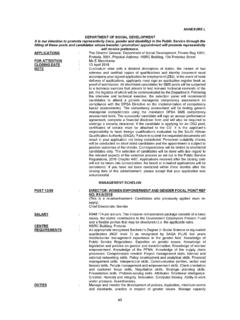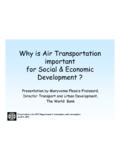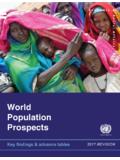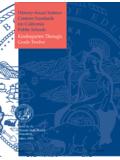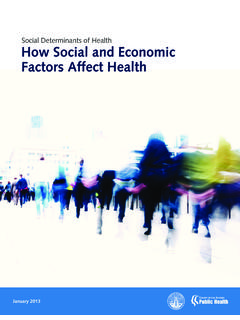Transcription of S o c i a l A f f a i r s International Migration Report 2013
1 E c o n o m i c &. s o c i a l A f f a i r s International Migration Report 2013. United Nations ST/ December 2013. department of Economic and social Affairs Population Division International Migration Report 2013. United Nations This page is intentionally left blank DESA. The department of Economic and social Affairs of the United Nations Secretariat is a vital interface between global policies in the economic, social and environmental spheres and national action. The department works in three main interlinked areas: (i) it compiles, generates and analyses a wide range of economic, social and environmental data and information on which States Members of the United Nations draw to review common problems and take stock of policy options; (ii) it facilitates the negotiations of Member States in many intergovernmental bodies on joint courses of action to address ongoing or emerging global challenges; and (iii) it advises interested Governments on the ways and means of translating policy frameworks developed in United Nations conferences and summits into programmes at the country level and, through technical assistance, helps build national capacities.
2 Note The designations employed in this Report and the material presented in it do not imply the expression of any opinion whatsoever on the part of the Secretariat of the United Nations concerning the legal status of any country, territory, city or area or of its authorities, or concerning the delimitation of its frontiers or boundaries. Symbols of United Nations documents are composed of capital letters combined with figures. This publication has been issued without formal editing. Suggested citation: United Nations, department of Economic and social Affairs, Population Division (2013). International Migration Report 2013. ST/ Copyright United Nations 2013. All rights reserved Printed in the United Nations, New York This page is intentionally left blank PREFACE. The Population Division of the department of This Report presents information on International Economic and social Affairs (DESA) of the United Migration levels, trends and legal instruments for Nations Secretariat is responsible for providing the major areas, regions and countries of the world.
3 The International community with up-to-date and data for the International migrant stock described in objective information on population and chapter I are taken from the two volumes of the development. The Population Division provides publication Trends in International Migrant Stock: guidance to the United Nations General Assembly, The 2013 Revision-Migrants by Age and Sex and the Economic and social Council and the Trends in International Migrant Stock: The 2013. Commission on Population and Development on Revision-Migrants by Destination and Origin, while population and development issues. The Division the estimates on the total population in chapter I are also undertakes regular studies on population levels, based on World Population Prospects: The 2012. trends and dynamics, including trends of Revision, DVD Edition. The estimates on net International Migration , changes in population Migration and the projected population up to 2050. policies and the interrelationships between presented in chapter II are based on World population and development.
4 Population Prospects: The 2012 Revision, DVD. Edition. Chapter III provides an analysis of the In the area of International Migration , the ratification status of Migration -related legal Population Division estimates the global number of instruments for Member States of the United International migrants at regular intervals, monitors Nations and the International Labour Organization levels, trends and policies of International Migration , (ILO), based on information from the United and collects and analyses information on the Nations Treaty Section and the NORMLEX. relationship between International Migration and Information System on International Labour development. The Migration Section also convenes Standards, which can be accessed at the interagency coordination meeting on and , International Migration and organizes expert group respectively. For more information on the data and meetings. As part of its monitoring activities, the methodology used for calculating the various Migration Section within the Population Division indicators used in this Report , please see the above- maintains the United Nations Global Migration mentioned publications.
5 Database, which contains the most complete set of statistics on International migrants enumerated in the The present Report has been issued without countries or areas of the world and classified by formal editing. Responsibility for this Report rests country of birth or citizenship, sex and age. The with the Population Division. Migration Section represents DESA in the interagency Global Migration Group (GMG). The This Report is available on the Population Section also services the intergovernmental process Division's website at For on International Migration and development at the further information about this Report , please General Assembly and acts within the Secretariat as contact the office of the Director, Population the focal point for the State-led Global Forum on Division, department of Economic and social Migration and Development (GFMD). Affairs, United Nations, New York, 10017, by telephone (+1 212)963-3179 or email at United Nations department of Economic and social Affairs/Population Division iii International Migration Report 2013.
6 This page is intentionally left blank CONTENTS. Page PREFACE .. iii EXPLANATORY vii CLASSIFICATION OF COUNTRIES OR AREAS BY MAJOR AREAS AND REGION IN THE WORLD .. ix International Migration LEVELS, TRENDS AND. LEGAL INSTRUMENTS. I. LEVELS AND TRENDS IN International 1. II. NET International Migration .. 11. III. LEGAL INSTRUMENTS AND POLICIES ON International Migration .. 19. United Nations department of Economic and social Affairs/Population Division v International Migration Report 2013. This page is intentionally left blank EXPLANATORY NOTES. The following symbols are used in the tables shown in this Report : Two dots (..) indicate that data are not available or are not separately reported. Three dots ( ) indicate that the treaty was not ratified. An em dash ( ) indicates that the amount is nil or negligible. A hyphen (-) indicates that the item is not applicable. A minus sign (-) before a figure indicates a decrease. A full stop (.) is used to indicate decimals. Use of a hyphen (-) between years, for example, 1990-2000, signifies the full period involved, from 1 July of the first year to 1 July of the second year.
7 Due to rounding, the numbers and percentages displayed in tables may not add up to the corresponding totals. The terms developed and developing regions are used for statistical convenience and do not necessarily express a judgment as to the developmental stage of a particular country or area. Where appropriate, the term country may refer to a territory or area. The developed regions are comprised of all countries of Europe, Northern America, Australia/New Zealand and Japan. The term developed countries refers to countries in the developed regions. Developing regions are comprised of all countries of Africa, Asia (excluding Japan) and Latin America and the Caribbean, as well as Melanesia, Micronesia and Polynesia. The term developing countries is used to designate countries in the developing regions. The group of least developed countries, as defined by the Committee for Development Policy (CDP), a subsidiary body of the United Nations Economic and social Council, currently comprises 49 countries: Afghanistan, Angola, Bangladesh, Benin, Bhutan, Burkina Faso, Burundi, Cambodia, Central African Republic, Chad, Comoros, Democratic Republic of the Congo, Djibouti, Equatorial Guinea, Eritrea, Ethiopia, Gambia, Guinea, Guinea-Bissau, Haiti, Kiribati, Lao People's Democratic Republic, Lesotho, Liberia, Madagascar, Malawi, Mali, Mauritania, Mozambique, Myanmar, Nepal, Niger, Rwanda, Samoa, Sao Tome and Principe, Senegal, Sierra Leone, Solomon Islands, Somalia, South Sudan, Sudan, Timor-Leste, Togo, Tuvalu, Uganda, United Republic of Tanzania, Vanuatu, Yemen, Zambia.
8 The designation sub-Saharan Africa refers to all countries in Africa except Algeria, Egypt, Libya, Morocco, Tunisia and Western Sahara. Countries and areas are grouped geographically into six major areas: Africa, Asia, Europe, Latin America and the Caribbean, Northern America and Oceania. These are further divided into 21geographical regions. Country names and the composition of geographical areas follow those of Standard country or area codes for statistical use (ST/ESA/ ), available at: m49 The following abbreviations have been used: DESA department of Economic and social Affairs GDP gross domestic product GFMD Global Forum on Migration and Development GMG Global Migration Group ILO International Labour Organization United Nations department of Economic and social Affairs/Population Division vii International Migration Report 2013. EXPLANATORY NOTES (continued). IMF International Monetary Fund IOM International Organization for Migration NGO Non-governmental Organization OECD Organisation for Economic Co-operation and Development UNGA United Nations General Assembly UNHCR United Nations High Commissioner for Refugees UNRWA United Nations Relief and Works Agency for Palestine Refugees in the Near East viii United Nations department of Economic and social Affairs/Population Division International Migration Report 2013.
9 CLASSIFICATION OF COUNTRIES OR AREAS BY MAJOR AREA AND REGION OF THE WORLD. AFRICA. Eastern Africa Middle Africa Northern Africa Western Africa Southern Africa Burundi Angola Algeria Benin Botswana Comoros Cameroon Egypt Burkina Faso Lesotho Djibouti Central African Republic Libya Cape Verde Namibia Eritrea Chad Morocco C te d'Ivoire South Africa Ethiopia Congo Sudan Gambia Swaziland Kenya Democratic Republic Tunisia Ghana Madagascar of the Congo Western Sahara Guinea Malawi Equatorial Guinea Guinea-Bissau Mauritius1 Gabon Liberia Mayotte Sao Tome and Principe Mali Mozambique Mauritania R union Niger Rwanda Nigeria Seychelles Saint Helena2. Somalia Senegal South Sudan Sierra Leone Uganda Togo United Republic of Tanzania3. Zambia Zimbabwe ASIA. Central Asia Eastern Asia South-Eastern Asia Southern Asia Western Asia 4. Kazakhstan China Brunei Darussalam Afghanistan Armenia Kyrgyzstan China, Hong Kong Special Cambodia Bangladesh Azerbaijan5. Tajikistan Administrative Indonesia Bhutan Bahrain Turkmenistan Region6 Lao People's Democratic India Cyprus7.
10 Uzbekistan China, Macao Special Republic Iran (Islamic Republic of) Georgia8. Administrative Malaysia9 Maldives Iraq Region10 Myanmar Nepal Israel Democratic People's Philippines Pakistan Jordan Republic of Korea Singapore Sri Lanka Kuwait Japan Thailand Lebanon Mongolia Timor-Leste Oman Republic of Korea Viet Nam Qatar Saudi Arabia State of Palestine11. Syrian Arab Republic Turkey United Arab Emirates Yemen 1. Including Agalega, Rodrigues and Saint Brandon. 2. Including Ascension and Tristan da Cunha. 3. Including Zanzibar. 4. For statistical purposes, the data for China do not include Hong Kong and Macao, Special Administrative Regions (SAR) of China. 5. Including Nagorno-Karabakh. 6. As of 1 July 1997, Hong Kong became a Special Administrative Region (SAR) of China. 7. Including Northern-Cyprus. 8. Including Abkhazia and South Ossetia. 9. Including Sabah and Sarawak. 10. As of 20 December 1999, Macao became a Special Administrative Region (SAR) of China. 11. Including East Jerusalem.










